
Additional Information
Book Details
Abstract
Reaching and Teaching Children with Autism provides a positive approach to understanding and educating children on the autism spectrum. The book gives greater insight into the perspective and behavior of a child with autism and explores how the child's learning preferences, strengths and interests can be used to facilitate learning and enhance motivation.
Based on well-researched theory and extensive clinical experience, the author provides a comprehensive model for developing lifelong independent learning skills in children with autism between the ages of 3 and 12 years old. The book describes the underlying principles, learning preferences and strengths typical of children with autism and offers a detailed but flexible program structure based on these concepts. Easy to follow activities and approaches are described in each chapter, along with clear examples and illustrations.
This accessible and practical book is an essential resource for parents, teachers, support workers, therapists and others concerned with learning and development in children with autism.
Educators and parents alike will find Reaching and Teaching the Child with Autism Spectrum Disorder a fine approach to educating kids with autism, offering insights on such a child's behaviour, blending research with clinical experience, and offering tips on developing independent learning skills with such kids. It's a key component of any parent or educator's library using a broad spectrum of proven autism teaching skills to reach kids hitherto deemed 'unreachable.
The Midwest Book Review
The model provides a comprehensive framework for understanding- and dealing more effectively with children with autism to allow them to develop lifelong independent living... Easy to read, practical and informative - a good resource to share with education colleagues when collaboratively planning and implementing reaching and learning programmes.
Speech & Language Therapy in Practice
Dr. Heather MacKenzie, a speech-language pathologist and educator by profession, has spent the past fifteen years of her 30-year career understanding the enigma of autism spectrum disorders (ASD). She has developed a Learning Preferences and Strengths model designed to determine each child's learning preferences and strengths and then `harness' them to improve the child's learning and development. Heather established a preschool program for children with ASD based on this model.
Speech-language pathologist and educator Mackenzie has developed a comprehensive model based upon theory and extensive clinical experience that she believes is effective at growing lifelong independent learning skills in children aged three to 12. She focuses on learning preferences, strengths and interests as she reframes the traditional definition of autism, describes the workings of her model and its program content, analyzes behaviours of children with autism, and shows how her findings apply to the model. Her suggestions are very practical, and she provides the addresses of free Internet resources and a wide range of forms to use in planning and observations.
www.booknews.com
This is an entertaining, informative and very practical book that will assist readers to `walk the talk' through a more positive paradigm for enabling children with autism. It is based on careful and systematic thinking by the author and incorporates methodology based on research and best practice experience.
Carmen Hengeveld, M.Sc., Registered Speech-Language Pathologist
This is a practical, inspiring and stimulating book.
Allison Waks, M.A., Registered Psychologist
Dr. Heather MacKenzie has used a unique blend of theories of personality type, multiple intelligences and mediated learning to create an elegant and practical method. I have seen how well the application of the Learning Preferences and Strengths model works for children with autism. It is my firm belief that this method has broad applicability for any learner.
Teeya Scholten, Ph.D., Registered Psychologist
A wealth of practical ideas to help children with ASD to succeed this would be a very useful book for professionals working with children with ASD in mainstream or special school settings.
NAPLIC Newsletter
I suggest that this book should be purchased by educators, parents and relatives of an autistic child as it focuses on the positivity of Autism rather than the difficulties this condition might bring. This book does a lot of positive and practical working. Also, there is a list of free internet resources.
TES Connect
Table of Contents
| Section Title | Page | Action | Price |
|---|---|---|---|
| Introduction | |||
| Principles | |||
| Pillar 1: Standards to ensure a quality child protection response | |||
| Pillar 2: Standards on child protection risks | |||
| Pillar 3: Standards to develop adequate strategies | |||
| Pillar 4: Standards to work across sectors | |||
| Glossary | |||
| Relevant legal instruments | |||
| Key resources for cross-cutting issues |
